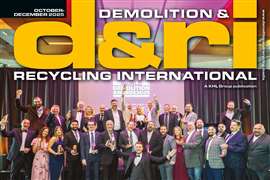The age of transport
15 April 2008
When SC&RA and the American Truckin g Associations SC&RA and (ATA the) Whenjointly organized the first Oversize-Overweight Transportation Symposium, 24-25 March 1988, in Dallas, Texas, there were no guarantees that the event would ever be held again.
Back then, an invisible, yet very real communications barrier existed between industry members and the transportation officials responsible for regulating them. In general, the two groups saw themselves as adversaries rather than as partners working to streamline the safe movement of oversize and/or overweight loads.
Moreover, there was very limited communication between transportation officials in various states. As a result, the industry faced a crazy quilt of permit policies, applications, fees and travel restrictions. “Whatever happened within their borders was all transportation officials seemed to care about at the time,”says Cheryl Reeves, COMDATA, who was with ATA at the time.
Bill Rieck, then SC&RA vice president of transportation, says the event grew from a single thought: great to bring everybody together under one roof?”.
As the big day approached, however, Reeves, Rieck and others involved in the planning began to grow nervous about whether the event would be successful. They worried about the possibility of low attendance or clashes between those who did show up.
Any doubt that there was interest in such an event was laid to rest when more than 300 participants from 31 states rolled into Dallas. Among the crowd were federal and state highway officials, permit engineers, equipment manufacturers, escort service operators, shippers and, of course, specialized carriers.
Lively and productive sessions covered such issues as permit uniformit y, truck and trailer technology, the role of computers in permit writing, shipper and carrier responsibilities; pros and cons of escort fication, the Federal Bridge Formula, enforcement of highway regulations, and the American Association of State Highway and Transportation Officials (AASHTO) Guide on Size and Weight.
In his presentation at the first symposium, Dennis Ehlert, director of the Iowa Department of Operating Authority, urged his fellow state officials to reach some form of agreement among themselves: “There is a critical need for an exchange of information; no longer can we act as independent states… fe miserable for truckers as well as shippers”.
That much-needed information exc h ange b egan to occur spontaneously – often in informal discussions. “You could look around and see people who had just met asking each other questions,”says Rieck. “They were laughing, having a good time. It was a wonderful thing, and we knew we wanted to do it again the next year”.
Reeves, who has attended each of the events (renamed the Specialized Transportation Symposium in 2003), says the atmosphere at the event has continued to improve. “Over the years, state officials have become much more open,”she points out. “It s so much easier to communicate when you have face-to-face dialogue. The progress we'vejust been incredible”.
Geoff Fischer, Trail King, agrees he says. “Both sides have opened up, and ‘us against them. officials hear first hand our concerns and needs, and industry hears the operations issues states have to deal with. Both sides have learned that y on the other side as they might have thought otherwise”.
Task force
Like Reeves, Fischer serves on Force and has never missed a symposium. Their companies also are among 15 corporate sponsors of the 2007 Specialized Transportation Symposium. Fischer says his company views its sponsorship, as well as its donation of his time for SC&RA committee work, as a way to give something back to the industry.
In addition, Trail King perennially operates a booth at the Specialized Transportation Symposium Exhibit Center. “That strengthens our efforts to network with our customers,”he explains. “You on that”.
Although it is also difficult to provide cost-benefit analyses of developments resulting from the symposia, there clearly have been significant breakthroughs.
“I believe the symposiums led the way in having State permitting agencies recognize the need for greater credentialing efficiency – both in general customer service and in computer technology,”says Lawrance Smith, who attended the symposiums from 1995 until 2003 before retiring as director of the Motor Carrier Division for the Texas Department of Transportation.
Smith valued the opportunity to discuss common issues facing both the industry and the various State and Federal agencies. “The symposiums really raised my understanding of the unique challenges that this segment of the motor carrier industry faces each day,”he notes.
One of the biggest changes Smith witnessed over the years was the increased level of professionalism. “The meetings became much more informational with a much wider array of speakers,”he says. “The subjects discussed expanded beyond simple permitting”.
Al Koenig, Midwest Specialized Transportation, Inc., says the symposium benefited from being merged with the Transportation Safety & Management Forum at the turn of the 21st century. “In order to have an outstanding safety program, you need to have the support of operations people,”says Koenig. “It seemed like a good fit. Why not combine the two events to get participation of the greatest number of participants?”
Koenig points out that the symposia began not long after economic deregulation. “We were trying to figure out how the chips were going to fall”.
It soon became clear to Koenig, as put price ta it did to many others, that economic regulation would increasingly be replaced with various types of social regulation. “Regulations focus now on aspects like how you spend your time in the truck and how y going to do the job,”he says. “You need to be active in the association to translate proposed regulations into real life and let regulators know some of these proposed rules are not workable. And you need to support those rules that are workable so we can move together toward efficiency and safety”.
Much of the g roundwork for change comes during the symposiums and other SC&RA meetings, when members sit down with other members to discuss the issues, according to Koenig. “Basically, the direction comes from members indicating what their problems are and what needs to be done,”Koenig explains. “After our meetings, we have to go back to our own jobs. Then staff has to run with our concerns, help resolve the issues – often workin g with coalitions of other associations – and report back to us”.
He praises SC&RA for taking positions on emerging issues and encourages SC&RA members to become active participants. Koenig believes that the more actively they participate, the more likely attendees are to gain the timely information and understanding they need to make prudent decisions in their businesses
“If you don't come away with good ideas on how to become a safer, more profitable carrier, missing the point,”he says
Many attendees also benefit long after the event by staying in contact with others they met. The communication continues to flow through an expanding network.
• Carriers call other carriers asking for technical advice or looking to form a partnership for a specific job.
• A state transportation official touches base with an official in another state concerning a tricky issue.
• An official calls a specialized equipment manufacturer for clarification about product specifications.
• E-mails fly back and forth between SC&RA and transportation officials as they seek common ground on a range of topics
Virtually all of these contacts contribute to the overall goal of streamlining the safe, efficient movement of oversize and overweight cargo. The process will be rejuvenated yet again at the 2008 Specialized Transportation Symposium next June in Pittsburgh, PA, US.




